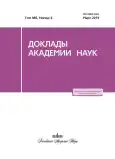Natural dicarbonyls inhibit peroxidase activity of peroxiredoxins
- Authors: Lankin V.Z.1, Sharapov M.G.2, Goncharov R.G.2, Tikhaze A.K.1, Novoselov V.I.2
-
Affiliations:
- Federal State Budget Organization National Medical Research Center of Cardiology, Ministry of Healthcare Russian Federation
- Institute of Cell Biophysics of the Russian Academy Sciences
- Issue: Vol 485, No 3 (2019)
- Pages: 377-380
- Section: Biochemistry, biophysics, molecular biology
- URL: https://journals.eco-vector.com/0869-5652/article/view/12896
- DOI: https://doi.org/10.31857/S0869-56524853377-380
- ID: 12896
Cite item
Abstract
It has been established that the activity of recombinant human peroxiredoxins (Prx1, Prx2, Prx4 and Prx6) inhibits by natural dicarbonyls formed during free radical peroxidation of unsaturated lipids (malonic dialdehyde) and oxidative transformations of glucose (glyoxal, methylglyoxal). The possible role of peroxiredoxins activity decreasing under oxidative and carbonyl stress is discussed as an important factor that includes molecular mechanisms of vascular wall damage in atherosclerosis and diabetes mellitus.
About the authors
V. Z. Lankin
Federal State Budget Organization National Medical Research Center of Cardiology, Ministry of Healthcare Russian Federation
Author for correspondence.
Email: lankin941@mail.ru
Russian Federation, Moscow
M. G. Sharapov
Institute of Cell Biophysics of the Russian Academy Sciences
Email: lankin941@mail.ru
Russian Federation, Pushchino
R. G. Goncharov
Institute of Cell Biophysics of the Russian Academy Sciences
Email: lankin941@mail.ru
Russian Federation, Pushchino
A. K. Tikhaze
Federal State Budget Organization National Medical Research Center of Cardiology, Ministry of Healthcare Russian Federation
Email: lankin941@mail.ru
Russian Federation, Moscow
V. I. Novoselov
Institute of Cell Biophysics of the Russian Academy Sciences
Email: lankin941@mail.ru
Russian Federation, Pushchino
References
- Seo M. S., Kang S. W., Kim K., et al. // J. Biol. Chem. 2000. V. 275. № 27. P. 20 346-20 354.
- Hofmann B., Hecht H. H., Flohe L. // Peroxiredoxins. 2002. Biol. Chem. V. 383. № 3/4. P. 347-364.
- Manevich Y., Shuvaeva T., Dodia C., et al. // Arch. Biochem. Biophys. 2009. V. 485. P. 139-149.
- Kinnula V. L., Lehtonen S., Kaarteenaho-Wiik R., et al. // Thorax. 2002. V. 57. № 2. P. 157-164.
- Шарапов М.Г., Гончаров Р.Г., Гордеева А.Е. и др. // ДАН. 2016. Т. 471. № 2. С. 241-244.
- Lankin V., Konovalova G., Tikhaze A., et al. // Mol. Cell. Biochem. 2014. V. 395. № 1/2. P. 241-252.
- Chapple S.J., Cheng X., Mann G.E. // Redox Biol. 2013. V. 1. № 5. P. 319-31.
- Ланкин В.З., Шумаев К.Б., Тихазе А.К., Курганов Б.И. // ДАН. 2017. Т. 475. № 6. С. 706-709.
- Sharapov M. G., Penkov N. V., Gudkov S. V., at al. // Biophysics. 2018. V. 63. № 2. P. 17-24.
- Kang S. W., Baines I. C., Rhee S.G. // J. Biol. Chem. 1998. V. 273. P. 6303-6311.
- WoodZ.A., Schroder E., Robin Harris J., Poole L. B. // Trends Biochem. Sci. 2003. V. 28. № 1. P. 32-40.
- Nelson K.J., Perkins A., Van Swearingen A.E.D., et al. // Antioxid. Redox Signal. 2018. V. 28. № 7. P. 521-536.
- Lo T. W.C., Westwood M. E., McLellan A.C., et al. // J. Biol. Chem. 1994. V. 269. P. 32 299-32 305.
- Zeng J., Davies M. J. // Chem. Res. Toxicol. 2006. V. 19. № 12. P. 1668-1676.
- Okado-Matsumoto A., Matsumoto A., Fujii J., Tanigu- chi N. // J. Biochem. 2000. V. 127. № 3. P. 493-501.
Supplementary files







